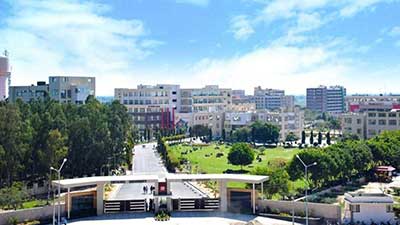Date: 30/03/2023
Relevance: GS-2: Social Justice, Sustainable Development Goals.
Key Phrases: Blended Financing, Sustainable Development Goals (SDGs), UNDP, Greenhouse Gas, Localisation of SDGs, SDG India Index, NITI Aayog, Climate Change, Inclusive and Sustainable Development, Partnership, Institutional Framework.
Reference:
- During the covid waves in India, several producers of raw materials required for face masks, vaccines and supply chains were struggling to meet demand as they fell short of working capital.
- To address this, multiple stakeholders- the Indian government,
USAID, The Rockefeller Foundation and other development agencies, financial
institutions, entrepreneurs, accelerators, and academia- launched a
blended financing entity called Sustainable Access to Markets and Resources
for Innovative Delivery of Healthcare (Samridh).
- This blending financing shows a great success to achieve its objectives.
- Similar blending financing should be adopted for achieving the SDG investment gaps.
Key Highlights
- The United Nations defines sustainable development as “development
that meets the needs of the present without compromising the ability of
future generations to meet their own needs”.
- The SDGs marked a paradigm shift in the development agenda.
- According to the Office of the High Commissioner of Human Rights, there is currently an annual shortfall of $4 trillion in developing countries, despite the combined sum of private capital flows, personal remittances, official development assistance (ODA) and private grants.
Need for Blended Financing:
- A policy brief by the G20’s Think 20 Engagement Group highlights
that several nations of the Global South are likely to fall short of
their 2030 sustainable development goals (SDGs) on account of a funding
gap.
- We must start working on filling this gap both through new investments and reallocation of existing capital.
- India’s finance minister has repeatedly highlighted the role of multilateral development banks (MDBs) in using innovative finance techniques to scale catalytic financing for SDGs to be met.
- Low-income regions, adaptation sectors and marginalized populations find
it harder to attract funding, due to small deal sizes, high regulatory
complexity and country-specific risks.
- Relying solely on philanthropy and government funding cannot address transnational challenges.
- Current public resources are not enough.
- Limited access to appropriate capital, fewer incentives for innovative practices and weak market intelligence and networks are among the reasons we must look towards the private ecosystem of blended finance solutions.
- Global crises like climate change and food insecurity can be fought by leveraging blended finance.
- Developing nations require an environment that lets private
investments thrive, which calls for activating policies that allow
private players and philanthropies to support their growth.
- Innovative blending can support project preparation and solve information gaps, enabling investment in multiple projects.
- It can work at the institutional level by blending public subsidies in the market to encourage private investments.
- With the Ukraine war, covid pandemic, increasing impact of climatic changes and natural disasters like the recent earthquake in Turkey and Syria, the SDG financing gap is widening.
Sustainable Development Goals (SDGs)
- About
- In 2015, the United Nations General Assembly officially launched the Sustainable Development Goals.
- SDGs were adopted as a universal call to action to end poverty, protect the planet, and ensure that by 2030 all people enjoy peace and prosperity.
- Over 150 world leaders representing 193 countries committed to working towards the SDGs through their policies.
- India is one of the signatory countries that has committed to achieving these goals by 2030.
- There are 17 SDGs focused on five elements: people, planet, peace, prosperity, and partnership.
- Background
- Originally, the UN and its members signed the Millennium
Development Goals (MDGs) in 2001.
- They expired in 2015.
- The United Nations took what worked from the MDGs and used those learnings to form the SDGs.
- Originally, the UN and its members signed the Millennium
Development Goals (MDGs) in 2001.
- Sustainable Development
- “Development which meets the needs of the present without compromising the ability of future generations to meet their own needs.”
- This most widely accepted definition of Sustainable Development was given by the Brundtland Commission in its report Our Common Future (1987).

Advantage of Blended Financing:
- Blended finance instruments can provide investors with distinct benefits, including the ability to tailor risks to specific needs, apart from capital loss protection and financial and social returns.
- It incentivizes and mobilizes private capital in emerging and
frontier markets where public resources and donor funds are limited.
- For example, Indian government support helped many organizations get finance at the incubation stage, though they must raise working capital through other means.
- To plug finance gaps, instrumental returnable grants and zero-coupon
loans can be of substantial help to organizations with high-impact
solutions, as these help meet short-term financial requirements (to be
repaid later).
- To mitigate risks, blended finance initiatives offer technical support, capacity-building aid, relevant data and tools for impact measurement, monitoring and evaluation.
- Successive grants are outcome-based, as set milestones must be achieved for further funding.
Way Forward:
- In view of the G20 Sustainable Finance Roadmap, India has emphasized the need to adopt innovative financing methods and can help the Global South develop blended finance instruments to meet SDGs.
- Emerging and frontier economies must step up advocacy of efficient access to fit-for-purpose catalytic capital to develop high-quality projects and expertise.
- We must unlock transition finance to build a tomorrow where no one is left behind.
Conclusion:
- With a range of development funders already showing strong political will and allocating funds to innovative mechanisms of finance, there is a growing momentum in support of blended finance as a systemic approach.
- India’s G20 leadership is thus the Global South’s moment to call for greater support and financial instruments.
Source: Live-Mint
Mains Question:
Q. What do you understand about blended financing? How this can fill investment gaps to meet SDGs by 2030. (250 Words).






















